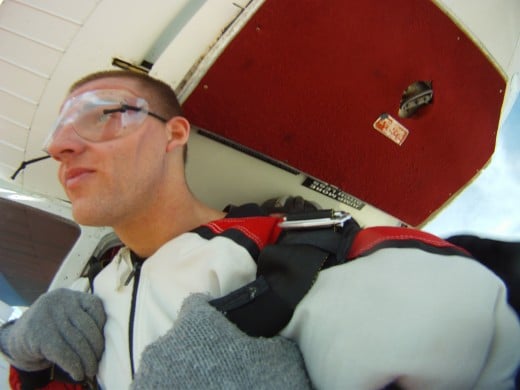Give Your Teenager Independence and You Peace of Mind

When our nineteen year old son announced that he was going skydiving, I was not surprised. He had joined the Marine Reserves after graduating from high school and was in peak physical condition. After his training, he obtained a position as a derrick hand in the oil field, earning enough money to purchase his own vehicle and fund a two year mission overseas for the church. Now, before leaving, he was taking a trip across several states to visit family members and have some recreation time.
Some children are born independent and learn very quickly. Others require careful instruction and much encouragement to spread their wings and do things on their own. As parents, we spend the majority of our time helping them master the skills that enable them to be on their own when the time comes. Yet, when they get to be teenagers, we have a difficult time letting go. We want to hold tight to those apron strings until we are sure that they are ready, and that leads to frustration for both the teen and the parent!
In order to give your teenager wings and you peace of mind, there are several things that need to happen: 1) teach choices, 2) provide boundaries, and 3) increase independence as the teen respects boundaries and makes wise choices.
Teach Choices
The more choices we give our children when they are young, the more they understand that choices have consequences. The color of crayon they choose determines how the picture looks when they make a mark on it. The consequence is immediate. If they don't like the result, they can choose a different color.
Not all choices have such immediate consequences, however. When we teach choices, we sometimes have to invent consequences to help our children choose good things. When our children were in elementary school, our family had the rule that chores needed to be completed before the children could spend time with their friends, watch TV, or play games on the computer. Chores included making one's bed, completing a housecleaning task, and seeing that school homework was finished. If they chose to goof off rather than doing these things, then the privileges were off limits. In some cases, they chose the undesirable option several times before finally deciding they wanted the privileges and finished their chores sooner. As the parent, I had to be firm and consistent in order for them to learn.
When we teach teenages choices, we need to help them realize that they are at a crossroads in their lives, and that their actions can and will affect them and others for many years to come. The food they eat, the amount of sleep they get, the people they hang out with, and the time they spend preparing for their future careers all make a difference in their future. Food becomes health and strength, sleep enables clear thinking, people seen regularly become spouses and business collegues, and time spent preparing for a career determines the future paycheck.
At the same time, teenagers live in the here and now, and their lack of experience leaves them somewhat shortsighted. They have a very strong need for peer acceptance and their feelings of self-worth are often hinged on what others think of them. The key to helping them make wise choices is to find out what they want here and now, then marry it to what we want for them in the future. As we do this, they are much more likely to choose things that are good for them.
Earlier in his life, our son wanted to spend time "hanging out" with friends. We wanted him to be safe, make wise choices, and stay clean from drugs and alcohol. Therefore, together, we mutually agreed on places that were "ok" to "hang out" that included our own home, homes of friends that did not engage in addictive behavior, school activities, and church functions. In order for him to choose other places to hang out with friends, a screening process was undertaken. The friend was invited over, we met the parents, the concern of possible drug and alcoholic activity was alleviated, and the okay was given to add this friend's home to the list of places to hang out. Even then, when he engaged in hanging out behavior, he had to let us know where he was, what he and his friends were doing, and the expected time of arrival home. Should he need to change plans, he was to notify us in a timely way.

Provide Boundaries
We have to develop boundaries around the choices our children make. Where we set these boundaries has a lot to do with the developmental milestones that have been met. Our son was in top physical condition, but he was not trained for solo diving. He was able to "tandem" dive, that is with an experienced diver strapped to him, someone who knew what to do in all aspects of the activity.
We teach our children when we show, tell, and do with them until they are able to do by themselves with our supervision. Then we allow them to do by themselves, yet we still follow up until we know that they master the skill. We set boundaries to keep them safe from harm and danger. Should we choose not to set boundaries, and children get hurt because they did not know about the danger, they loose trust in us as their parents. Children, especially teens, need to know why the boundaries are there. They need to understand that we are concerned for their safety and protection, and want what is best for them. As we teach boundaries, we also teach values. Values are the basis for decision making. They give a standard by which to judge, and a reason for making a particular choice.
As children enter the teen years, their boundaries move from specific places inside our home to other people's homes, the community as a whole, and the world. These boundaries need to be developed mutually with them, having a common ground between the parent and teen upon which the boundary is set. Both the teen and the parents understand the purpose of the boundary, what will happen when it is respected, and what will happen if it crossed, whether on purpose or inadvertantly.
Increase Independence as the Teen Respects Boundaries and Makes Wise Choices
The more responsibility our children are able to handle on their own increases our desire to allow them independence. Our trust in them increases and we are able to feel comfortable giving them additional freedom. There must be mutual understanding, however, that should freedom be misused in any way, independence is decreased until trust is re-established.
Just as we are evaluated on our performance in our work, and pay is determined accordingly, we help our children prepare for their better future by doing frequent evaluations of their performance. A school provides regular marks through issuing report cards. We can do the same with our children. Perhaps on their birthday, or when school begins and ends, or even at semester time, we can sit down and look at what has been accomplished. This is a time to give our children feedback, compliment them on the things they are doing well, and encourage them to do better in things that are coming up in the future. Goals can be set, needed skills determined, and a plan of action put in place. Regularly looking forward to our children's future helps them to look forward to it as well and gives them a reason to prepare.
Teens need to understand the responsibilities that will be theirs when they leave home. Preparation for adequate housing, medical needs, job skills, career advancement opportunities, relationship building, and spiritual enrichment all come from skill development within the home. Time taken now means less time spent in these activities later when they flounder as adults. Teens are much more likely to be successful on their own when they are well-schooled in taking care of themselves and their belongings in the home.
Take the time now to teach you teen how to make appropriate choices. Set boundaries for their safety and protection, and teach them to set their own as well. Keep their independence increasing rather than getting in the way. As you do so, you are standing with the door wide open, the runway cleared, and feel good enough about what is happening to cheer them during takeoff!
This content is accurate and true to the best of the author’s knowledge and is not meant to substitute for formal and individualized advice from a qualified professional.
© 2012 Denise W Anderson






